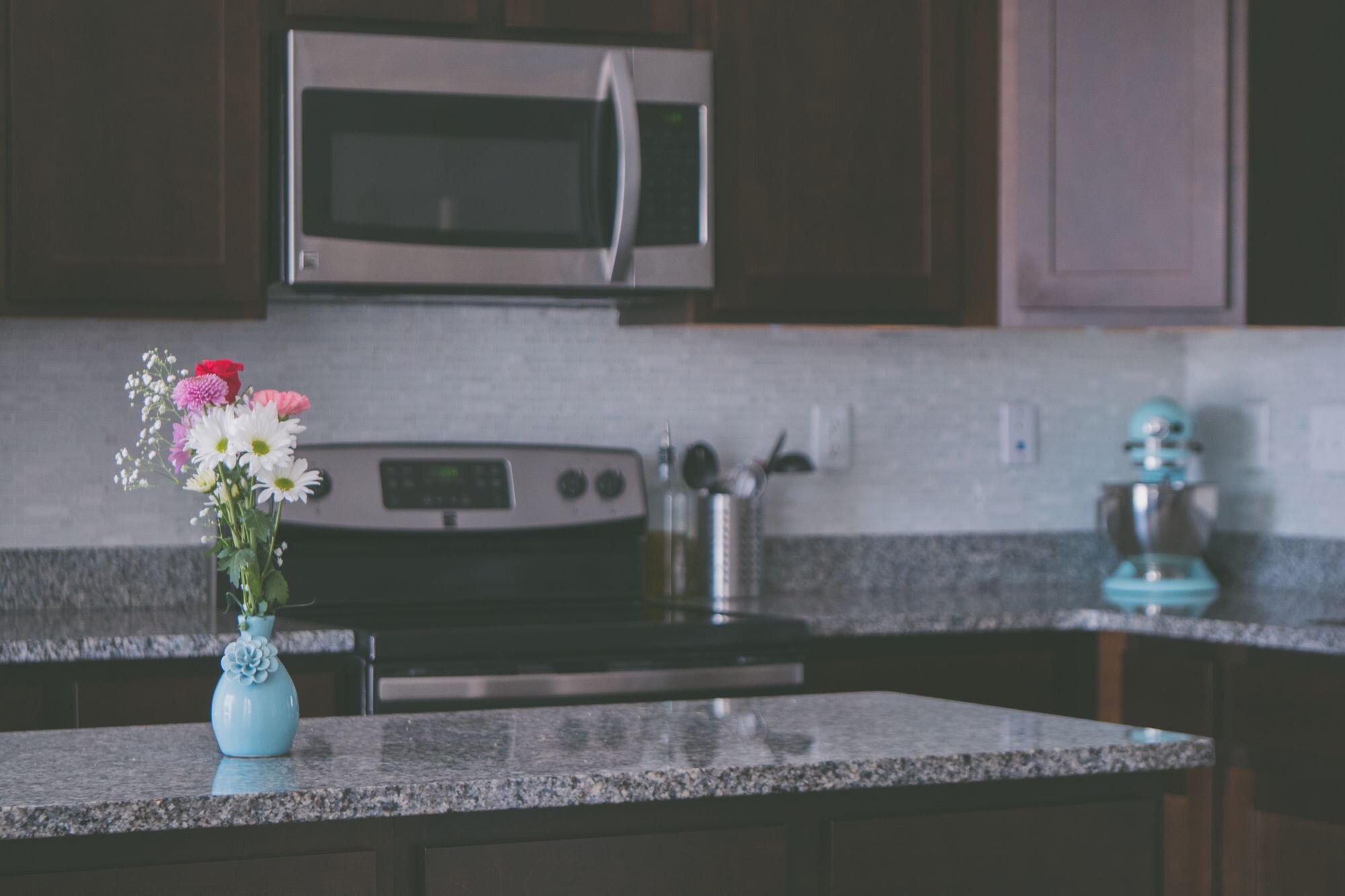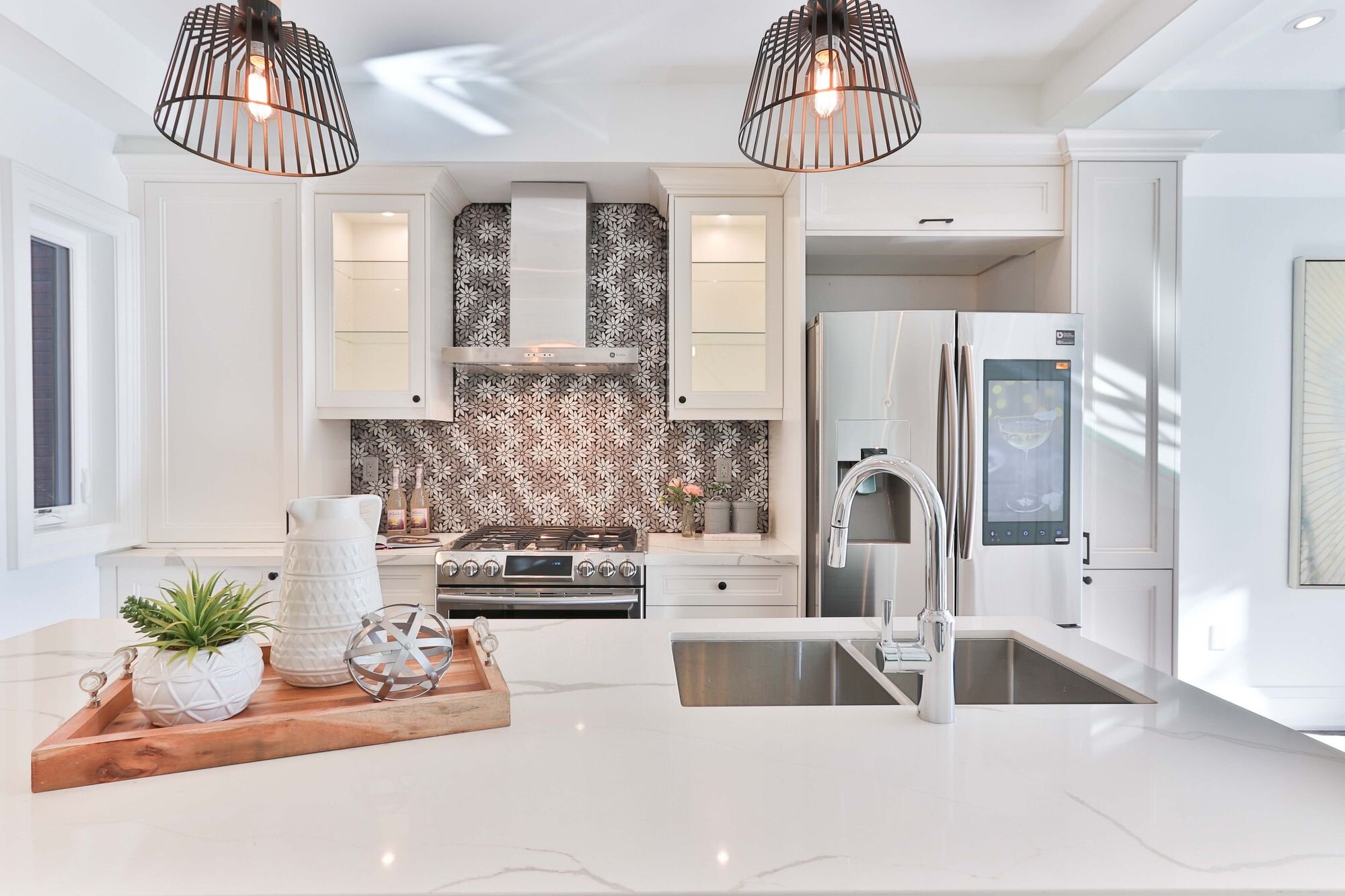A Designer's Guide to Choosing Countertops
When building a new home, or renovating your current home, many people do not know what to look for when choosing their countertops. It can be confusing and frustrating not knowing what material, what thickness, nor the process of choosing a countertop. We've put together this designer's guide to choosing countertops to help you enjoy the process of finding the perfect countertop for your home.
Material
There are many materials from which countertops are made, with widely varying price points. On the lower end of the budget are laminate countertops and solid surface (e.g., Corian) countertops. Laminate countertops come in a variety of patterns and colors and are a very affordable option. They are somewhat durable, but can have issues with spreading at the seams, and if dinged, they are not repairable. Also, since they have a particle board backing, they can absorb water, and you therefore need to seal the underside of the counter above a dishwasher. Solid surface countertops are not as popular as they once were, although they are affordable and durable. They are a man-made, acrylic product with a plastic-like feel if you tap on them with your fingernails. If you have seen a counter with a seamless, integrated sink all in one piece in an older home, it is likely a solid surface product.
A currently much more popular man-made product is quartz. Quartz counters are made from crushed quartzite (a natural stone) that undergoes an intense process of heat and compression with resins that bind it together into a very dense, stone-like product. Quartz has become popular because it is very durable, non-porous, low maintenance, and doesn’t stain or etch. It comes in a variety of colors, and marble-look quartz (with patterns imprinted that are designed to look like marble) is currently on trend. While many quartz options have flecks of the stone material, others have a more uniform appearance. Although quartz prices have decreased, they are still on par with some less expensive natural stones. One downside we recently heard about is the resin in quartz reacting to heat, such as the usage of crock-pots on the counter, and the resin turning yellow. It is therefore important to protect your quartz countertops from prolonged heat exposure.
Natural stone countertops are enjoying great enthusiasm, while also generating anxiety about maintenance among homeowners. Granite has been a prevalent choice for its appealing patterns and durability. Although granite is typically associated with darker counters, there are a variety of lighter granites as well. As natural stones go, granite is one of the densest and most durable, although it should be sealed once or twice a year. The process of sealing natural stone is typically a simple wipe on, wipe off process with an over-the-counter product. Granite can have bold patterns and/or a spotted pattern, which may not be for everyone. The price point for granite varies with the actual stone selected, although it is typically a more affordable natural stone.
Marble is a beautiful, natural stone that is currently on trend and is also a great source of debate. The softness of marble is clearly evidenced by historic churches with marble steps that have worn indentations from centuries of footsteps. Marble is less durable than granite and can scratch, stain, and etch (meaning if you leave a glass with a ring of orange juice on the bottom, the ring will remain after you clean it up, if you don’t clean it right away). Polished (glossy) marble is more likely to etch than honed marble (sanded to a smooth, matte finish) because that orange juice circle will eat through the glossy finish, creating a dull ring. In a kitchen or other high-use area, honed marble may be more practical if etching is a concern. In fact, one fabricator told me that he has had several clients with polished marble in the kitchen subsequently ask him to come back and sand it into a honed finish to get rid of etching. There are impregnating sealers that can be applied to add some longevity to your marble. You can ask your fabricator to apply a sealer before installing your countertops to protect them from the start, but you will need to reseal them once or twice a year after the factory sealer wears off. At the Washington Schoolhouse boutique hotel in Park City, for example, they seal their marble bathrooms every 3 months. The cost of marble can vary widely, with carrara typically being more affordable than calacatta. Carrara typically has a grayer background and less dramatic veining than calacatta, which is typically more white, with bold, gray veining. One must ultimately weigh the beauty of marble against the potential angst over its delicate nature and whether flawless countertops is expected or not.
Quartzite, often confused with quartz, is a natural stone with striking gray linear veining and is a more durable alternative to marble, with a similar look. Like other natural stones, however, it should be sealed and can scratch and stain. The main downside to quartzite is its high price tag, but its allure and durability are worth it to some.
Soapstone has been associated with chemistry classes, as it was a staple in many labs due to its imperviousness to heat and chemicals. Like marble, soapstone is soft to the touch, but it will not stain, like other natural stones. It therefore does not need to be sealed, but many choose to oil their soapstone counters, which darkens the look of the counters, adding richness. If the soapstone is on either side of a stove with frequent oil splatters, however, these will likely be visible on an un-oiled counter. It is also possible to have issues with rubber feet from small appliances on soapstone counters. The color of soapstone can vary, but most have gray or green hues, with lighter, dramatic veining on a darker background. The softness of soapstone means that it can scratch easily, although there are repair kits that can make dings and scratches imperceptible. A relatively rare option, soapstone is definitely on the higher end of the cost spectrum.
Wood countertops have circled back into vogue, with the current farmhouse and rustic kitchen trends. Adding a richness to an all-white kitchen, wood countertops are an interesting alternative to stone, or can be used on a kitchen island for contrast. Sealing the wood is a point of consideration, as it’s important to weight an industrial strength sealer vs. a food safe product. Some species of wood are more naturally resistant to water than others, but all wood will need some protection from repeated water exposure, especially next to a sink. Wood also scratches and is not heat resistant. Wood can potentially be sanded to remove minor surface issues, however. The price point for wood counters can be surprisingly high, again depending on the species of wood.
For a modern design, concrete countertops may be an option; however, the craftsman who is creating the concrete countertop must truly be a craftsman with substantial knowledge and experience to avoid the many potential pitfalls of this type of creation. Just like a sidewalk, concrete can have issues with cracking and chipping if not formed or maintained properly. Surprisingly high maintenance, concrete countertops should be sealed monthly. Although cost effective in materials, that expert craftsman you hire will not be inexpensive. Concrete countertops are for those who are willing to go the extra mile for that unmistakable concrete look.
Thickness and Edges
The countertop thickness is something you’ll want to consider early in your search. Quartz and natural stone counters are measured in centimeters, with the two options being 2 CM and 3 CM. You’ll find that 2 CM is more common in slab yards than 3 CM, depending on the type of stone you are looking for. Since 2 CM can look a bit thin, it is possible for your fabricator to cut a strip of stone and miter it to the edge of the counter, creating an illusion of a thicker counter (it will be thicker than 3 CM). This additional labor will increase your fabrication costs, however, which may add up to the same cost as getting a 3 CM stone in the first place. You’ll want to do some early research on whether you prefer 2 CM or 3 CM when you are working with your cabinet designer, as he or she will need to know your countertop thickness in order to make your countertops the desired height (typically 36”).
Most homeowners haven’t thought much about how they want the edge of their countertops to look until their fabricator asks them. Ask to see examples of the different styles of edges when meeting with your fabricator. The most popular edges currently are a square edge and an “eased” edge. A square edge means that the countertop has close to a 90 degree edge, with minimal rounding on the edge. An “eased” edge is similar, typically with 1/8” filed off of the top edge. A quarter round edge has ¼” filed off of the top edge, while a bullnose has an even more dramatic rounded edge. A full bullnose means that the underside edge is also rounded. Instead of being rounded, a beveled edge has distinct angles as it slopes down. An ogee edge has a decorative profile, with a square edge and then a cove and a bullnose. Once a staple in high-end, traditional kitchens, ogee edges (as well as rounded and beveled options) have fallen out of favor with most homeowners, as the clean look of square and eased edges are more common today.
Process
The process of getting countertops can be confusing and frustrating, but it doesn’t need to be. Unlike our typical purchasing experience—buying a shirt, let’s say—countertops involve two entities: stone suppliers and fabricators. Using the shirt example, it would be like buying the fabric and then hiring a seamstress to sew the shirt for you. Stone suppliers sell the slab, and fabricators pick up the slab directly from the supplier and then measure and cut the countertops to fit your cabinets. There are many great stone suppliers / slab yards in the Salt Lake City area from which to choose, including Stone Collection, Arizona Tile, Dal Tile, Contempo, Bedrosian, Cosmos, Italia, Venetian Stone, Francini, and Midwest (quartz only). In my personal experience, Arizona Tile, Francini, and Stone Collection in particular have excellent customer service and extensive options. Most stone suppliers will only hold your slab for up to two weeks, although it can be longer if you already have a fabricator. If you don’t have a fabricator, the slab yard will likely have a list of preferred fabricators (and vice versa if you need a slab yard).
If you think you like a slab, you should probably err on the side of putting it on hold so that it doesn’t get snatched up by someone else, although set a reminder for yourself to release it once the time expires or when you find something you like more. Similar to wedding dress shopping or looking at fine artwork, when you find what you love, you’ll know it. Take photos of any tags, numbers, and/or other identifying information on the slab (typically on the side edge of the slab or sometimes in a tag taped to the front of it). When you put the slab(s) on hold, let the supplier know who your fabricator is, and notify your fabricator of the supplier and identifying information of the slab(s). Only the fabricator can give you the actual price of the countertop (including material and labor), but most slab yards have Group numbers that indicate cost, from low to high, or some will give you a rough per square foot cost. Armed with all of this knowledge, you’ll be able to minimize your effort and enjoy the process of finding the perfect countertop for your home.







